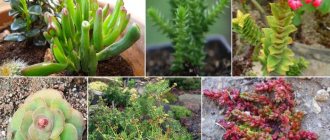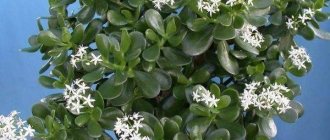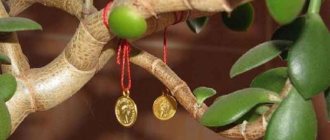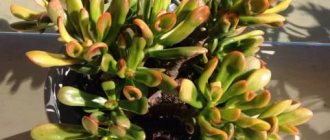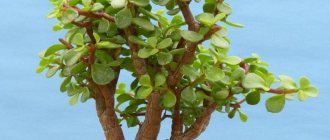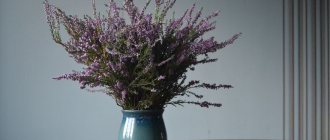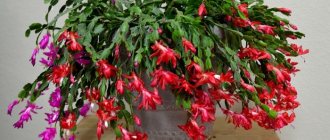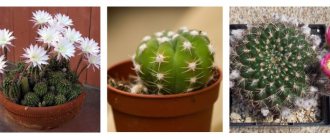Crassula ovata The Hobbit
The extensive Crassula family was replenished with a new variety of Crassula Hobbit in the middle of the last century. The flower is attractive not only for its ease of care, but also for its unusual appearance.
Crassula the Hobbit - an unusual succulent
Description
The peculiarity of the plant is the unusual shape of the leaves. Unlike ordinary Crassula, they are not round, but elongated. The edge of the leaf plate resembles a funnel, which is framed by a thin reddish border.
The shape of the flower resembles a small tree with fleshy and powerful stems and lush green leaves. In older specimens, the trunk may become partially woody. Crassula flowers are inconspicuous, small and have a pale pink tint. In indoor conditions they appear very rarely.
Origin story
Crassula Hobbit (crassula ovata hobbit) appeared thanks to the work of American breeders in the 70s of the last century. By crossing the Ovata and Molochnaya varieties, it was possible to obtain a new interesting species. The flower received its name due to the publication of Tolkien’s work “The Lord of the Rings”.
During the crossing experiment, another species was obtained - Crassula gollum. Externally, the plants are similar, but their leaf shapes are different. Crassula Hobbit has funnel-shaped leaves, fused only at the base, while Crassula Gollum has leaves fused along the entire length and widened towards the edge. There is an even later species that is similar in appearance to both of the above - Crassula Coral.
Crassula Gollum is very similar to the Hobbit variety
What similar plants are there?
- Crassula lactea. Crassula milky. One of the ancestors of the hybrid variety Crassula ovata “Gollum (Hobbit)”. This species has only a hint of fusion of leaves a la “Gollum” - they grow together at the base. The plant is small (up to 60 cm in height maximum). Delicate wide rounded leaves, white flowers - a very nice specimen for a succulent grower’s collection!
- Crassula portulacea. Crassula purslane. Also a popular succulent with elongated, obovate leaves on thick stems. Decorative and practically obligatory in the collection of home succulents of the Crassulaceae genus.
- Adromischus halesowensis. Adromiscus halesowensis. If you like the exotic, somewhat “alien” look of “Gollums” (“hobbits”) and want something similar for your collection, then you will like Adromiscus. Elongated, voluminous, glossy leaves stretching in different directions give this bush a unique, special charm.
- Peperomia graveolens. Peperomia graveolens. A cool plant with thick, oblong leaves folded into “boats.” The shape is not everything: the leaves are green on top and red below. The decorativeness is off the charts!
- Hatiora salicornioides. Hathiora saltwort. Epiphyte cactus. Its branchy green shoots resemble horns and look like cute “hobbit” leaves. If you liked the “Gollum” variety of Crassula and want something else in the same spirit for your collection, Hatiora will definitely suit you.
Home care
Crassula ovata crassula ovata - what kind of flower
Crassula the Hobbit is unpretentious, like all succulents. Even insufficient humidity, poor watering and lack of fertilizing do not prevent this plant from growing. But in order for the flower to fully develop, some requirements must still be met.
| Lighting | Lighting should be diffused, but with high daylight hours. Direct sunlight should be avoided. A little shading in winter is acceptable. |
| Temperature | In the spring and summer, the optimal temperature is +17... +20 °C. In winter, it is better to lower the values to +14... +16 °C with a difference between day and night temperatures of 2-3 °C. |
| Watering schedule | The soil should be moistened moderately and regularly, as the soil dries 2-3 cm. In winter, watering is reduced to 1-2 times a month. |
| Air humidity | Optimal humidity levels are 60-70%, but the plant feels comfortable even at lower air humidity. |
| Feeding | There is no special need for fertilizing, but as the flower grows and the soil becomes depleted, fertilizers should be periodically applied. You only need to use special compounds for succulents. |
| Soil composition | It is best to use a ready-made substrate for succulents. If the mixture is prepared independently, then the composition must contain broken brick or small expanded clay. |
| Pot size | The root system of the flower is not very developed and rather superficial. A container of small diameter and medium depth is suitable. |
Attention! Crassula tolerates short-term drought better than waterlogging, so it should not be watered too often.
Crassula Hobbit is especially suitable for beginning gardeners. Even if you don’t have much experience in growing plants, you definitely won’t have any problems with this flower.
Crassula is a very unpretentious flower
Landing
When planting Crassula "Hobbit", special attention should be paid to preparing the substrate and choosing a pot. You can pick up the soil mixture at the store. It is better to stay with a composition intended for cacti and succulents. However, you can make the substrate yourself from available components. You need to take:
- 1 part sheet soil;
- 1 part river sand;
- 1 part turf.
All components can be assembled in an environmentally safe place away from major roads and highways. It is also necessary to add a little crushed coal, zeolite and fine expanded clay to the prepared mixture. All components must first be calcined on a baking sheet in the oven - this will destroy the larvae of insect pests, as well as pathogens of fungal, viral and bacterial infections.
You should definitely put drainage at the bottom of the container; it should occupy at least a third of the pot. Usually pebbles or expanded clay . This is very important, since stagnation of water leads to waterlogging of the soil, and this has the most detrimental effect on the condition of the root system and leads to the shedding of leaves.
The root system of Crassula is superficial, so it is better to choose a low, but wide and flat pot for the plant. It is in such a container that the fat woman will be as comfortable as possible. The diameter of the pot should approximately correspond to the size of the crown. If it is smaller, the roots will be cramped. If you take a larger pot, the Crassula will grow and develop very slowly.
Keep in mind that a mature plant is quite heavy. The pot must be stable to support the overgrown tree.
The container can be made of any material, but since the flower looks very impressive and resembles a bonsai, it will look best in a ceramic or clay container. If you wish, you can even pick up a special bonsai. There is also one important requirement for Crassula pots - they must have several drainage holes to remove excess moisture from the substrate.
If optimal conditions are created, Crassula will delight its owners for many years. The plant is very demanding of good lighting . The best place for it is a south or southwest window. In a shaded place, the succulent will also fully develop and grow if you place it in a well-lit place for a couple of hours a day.
However, keep in mind that when left in the shade for a long time, Crassula “Hobbit” leaves begin to stretch and then fall off. In addition, the flower becomes more faded and completely loses its decorative effect. In this case, it will be quite difficult to restore the appearance of the plant.
The optimal temperature for Crassula, as for all other Crassulas, is considered to be between 20-25 degrees. In summer, the flower can be placed on the balcony, terrace or veranda. In winter (during the rest period), you can reduce the heating to 10-15 degrees. In winter, the plant needs coolness; only in this case will it be able to produce full flowering in spring or summer.
If there is no cold period, then you should not wait for the appearance of buds; such a plant will only increase its green mass.
Succulents, which include the Hobbit Crassula, can withstand short temperature fluctuations. They are able to withstand both sharp declines and rises, because this often happens in their natural habitat. Artificially bred varieties inherited this useful quality from their ancestors.
Room humidity has virtually no significance for the crop. It tolerates both the dried air of metropolitan apartments and the hot heat in the summer. However, a periodic warm shower will not harm your green pet - this will restore the leaves’ glossy shine and bright color.
After the procedure, you need to gently shake the flower pot so that all drops of water roll off the leaf plates. The plant must dry out in the room. If you expose it to the sun, water burns may appear on the surface of the leaves.
Trimming
If you intend to form a beautiful, spectacular crown, special attention should be paid to pruning . If you want to get a thicker trunk, then you need to trim the side shoots quite early. To give the crown the required shape, shoots should be regularly pinched and weeded out with clean, almost sterile pruning shears. After the procedure, the cut areas should be sprinkled with activated carbon.
You can even form Crassula in a fantasy style, especially if you grow the plant as part of a composition or as an element of a mini-garden.
Features of transplantation
Considering the rather slow development of the Crassula root system, it does not need frequent replanting. It is enough to replace the soil and pot every 2-3 years.
Crassula - home care
Step by step procedure:
- The flower is watered 2-3 days before transplantation.
- The plant is removed by transferring it, holding it by the trunk.
- A drainage layer is poured onto the bottom of the container, which should occupy ¼ of its volume.
- Pour the prepared soil into the pot.
- Carefully place the plant in the center of the container.
- Fill the pot with the remaining soil and water it.
- After the soil settles, add soil to the edge of the container.
Attention! All manipulations with the flower are carried out carefully, as there is a risk of accidentally breaking off the leaves.
Although Crassula does not need frequent replanting, replacing the soil will benefit it in any case. The flower quickly takes root in the new container and begins to intensively increase its vegetative mass.
Flowering and dormancy
Crassula - types and varieties, Moss and Perforata
Crassula Hobbit blooms very rarely and inconspicuously at home. But in winter, the plant still needs a period of rest. To do this, the flower needs to create conditions for the transition and stay there until spring.
Crassula flowers are small and inconspicuous
At the end of autumn, the average daily temperature is lowered to +14... +16 °C and the frequency of watering is gradually reduced. Fertilizing stops starting in October. If the flower is on the south window at home, then in winter it is better to move it to a less lit place. With the onset of spring, they gradually switch to a standard care regimen.
Facts about this Crassula Ovata Hobbit
These flowers belong to the Crassulaceae family, and their homeland is South Africa. If we talk specifically about the “Hobbit” variety, it was discovered in the 1970s and grows in its natural habitat on rocky slopes.
The tips of the Hobbit have a reddish tint. Photo used as illustration. Source: Yandex.Images
The succulent has a shrub-like form and erect foliage. The trunk is branched, so it can be easily shaped into a bonsai. The edges of the leaves have a red tint, especially if the plant is grown in bright light.
New growth is also red. The pinkish-white flowers appear in clusters and look like stars. Flowering time usually occurs in late autumn or winter, but you need to understand that the tree blooms only in ideal conditions.
The common Crassula is often called the "Money Tree", but this variety has its own names, such as Jade Fingers or Hobbit Tree. But despite this, the tree is also considered lucky and, according to Feng Shui practice, attracts positive energy into the house.
Reproduction
The ease of growing Crassula concerns not only care, but also reproduction. The plant takes root easily and quickly using leaf and stem cuttings. You can grow a flower from seeds, but this is a labor-intensive and time-consuming process that gardeners rarely resort to.
Cuttings are rooted directly in the soil without keeping them in water. Sometimes planting is carried out in the same pot where an adult plant grows. There is no need to create greenhouse conditions. You just need to monitor the soil moisture, but at the same time prevent it from becoming waterlogged.
Young seedlings take root quickly
Possible problems during cultivation
Diseases and pests rarely affect Crassula. More often, the flower suffers from improper care, especially from non-compliance with the watering regime. Excessive waterlogging of the soil can lead to the development of root and stem rot.
Attention! In addition to the watering schedule, the correct composition of the soil plays an important role - it must allow water to pass through well. When choosing a pot, you should pay attention to the presence of a sufficient number of drainage holes.
A flower can only get sick through infection from other plants. At the first signs of deterioration in appearance, you should treat the flower with special means or use traditional methods.
Crassula Hobbit is an unusual plant that does not require much attention. Caring for the flower is easy, so even a novice gardener can grow it.

